The familiar robin is among the wildlife partial to a blackberry! Photo by Logan Walker.
Our top 10 wildlife sightings for August
A gatekeeper butterfly with its distinctive eyespot. Photo by Logan Walker.
Bountiful blackberries
One of the most exciting sights of August is bulging dark blackberries gleaming in hedgerows waiting to be picked. In the UK there are more than 300 recognised varieties or 'microspecies' of blackberry - some of them tiny and tart, some of them succulent and sweet, but all of them providing invaluable sugary fuel for birds, mammals and insects, so if you do go picking, please leave a few for the animals!
A baby hedgehog (or hedgehoglet) by Gillian Day
Hedgehoglets
An animal which definitely needs our help is the hedgehog. In the past two decades, the number of hedgehogs in the UK has plummeted from an estimated 1.5 million to around 500,000. Housing estates with impenetrable garden fences, pesticides killing invertebrate food sources and general pollution are all contributory factors. Putting out bowls of water is a great, simple way to help - especially with vulnerable hoglets wandering around at the hottest time of the year.
Golden-ringed dragonfly by Vaughn Matthews
Golden-ringed dragonflies
Late summer is a great time to spot lots of dragonflies and damselflies hovering around ponds, lakes and streams, but also zipping across gardens and even through urban areas as they hunt for new breeding grounds. One of the most spectacular is the golden-ringed dragonfly - the UK's longest species, and a voracious predator of smaller insects. Look out for these golden beauties at Wildmoor Heath and Snelsmore Common in Berkshire. College Lake near Aylesbury is also a fantastic place for dragonfly spotting - join us there on 10 August for a pond-dipping workshop for adults!
A gatekeeper butterfly with its distinctive eyespot. Photo by Logan Walker.
Gatekeeper
The gatekeeper butterfly is on the wing in summer. Look out for the large, distinctive eyespot with two 'pupils' on each forewing. It's similar to the meadow brown butterfly, so look closely – the combination of bright orange wing patches, one large eyespot on the forewing and one smaller eyespot on the hindwing is unique to the gatekeeper.
It’s a butterfly of grassland, hedgerows and woodland edges and can be seen feeding on wild marjoram, bramble and ragworts.

Devil's bit scabious by Amy Lewis
Devil's-bit scabious
The pincushion-like, lilac-blue flower heads of Devil's-bit scabious also attracts a wide variety of butterflies and bees. Found in damp meadows, marshes, and on riverbanks, see if you can spot them at Lashford Lane Fen near Abingdon or at Woodsides Meadow south of Bicester.
The name ‘scabious’ comes from the Latin scabere, meaning to scratch, after its traditional use as a treatment for skin conditions such as scabies and the sores of bubonic plague. Its diabolic association arises from the fact that its roots look truncated as if bitten off by the Devil – as legend has it, he was angry at the plant for foiling the misery he created with these skin ailments!
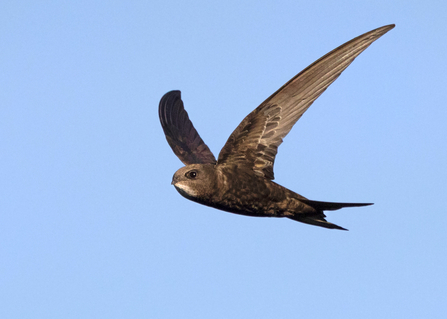
Common swift in flight by Jon Hawkins
Swifts flying south
August is often known as the time of year 'when the woods go quiet', as most birds have finished their mating season and many of them have already begun to migrate south for the winter. Among the latter are swifts: having spent the past month or two screaming above our heads they are now starting their great journey back to Africa - look out for them while you can.
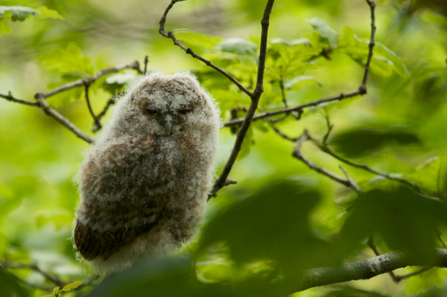
A tawny owl chick 'branching'. Picture: Tom Hibbert
Tawny owl fledglings
One bird that very much remains in the UK is the tawny owl. Chicks are born in April and May, and just three months later the fledglings are starting to leave the nest to go and start their own families. Tawnies are strongly territorial and as summer turns to autumn they start making their famous 'twit-twoo' calls to establish their dominion – the female makes the ‘twit’ while the male answers with its ‘twoo’!
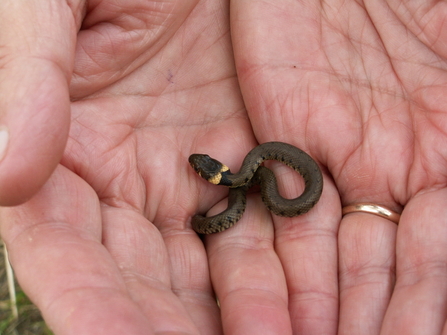
Juvenile grass snake in the hand. Picture: Margaret Holland
Baby grass snakes
Another of nature’s newborns to look out for are grass snakes. These reptiles are the only egg-laying snake in the British Isles, because adders and smooth snakes incubate their eggs internally until they hatch. Female grass snakes usually lay their eggs in June or July and many of them will start to hatch in August - perfect, miniature versions of the adults. Look out for them in fields, meadows and heathlands like our Sydlings Copse reserve near Oxford and Snelsmore Common near Newbury.
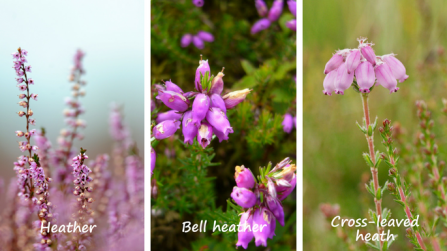
Heather
There are three species of heather to look out for: heather or ‘ling’, bell heather and cross-leaved heath.
- Heather is the classic heathland plant that turns heathland shades of purple and pink in August and September.
- Bell heather has vibrant purple bell-shaped flowers and grows on drier parts of heathland.
- Cross-leaved heath grows on wetter, boggier areas of heathland, where the soil is more acidic. The greyish-green leaves grow in groups of four, in a cross-shape, up the stem and the pale pink flowers form a cluster at the top of each stem.
Great heathland reserves to visit to see swathes of pinks and purples include Greenham Common, Snelsmore Common and Wildmoor Heath.
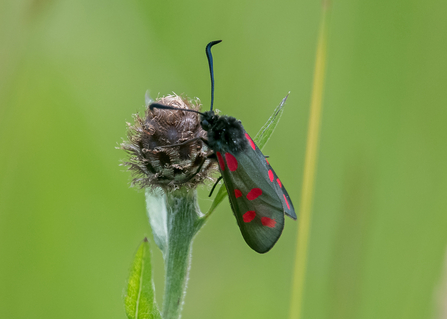
Six-spot burnet moth by Andrew Marshall/Go Wild Landscapes
Six-spot burnet moth
The six-spot burnet moth is a day-flying moth that flies with a slow, fluttering pattern. Look for it alighting on knapweeds and thistles in grassy places. It is glossy black, with six red spots on each forewing.
The red spots of burnet moths indicate to predators that they are poisonous: they release hydrogen cyanide when attacked. Don't confuse them with another black and red day-flying moth, the cinnabar.




